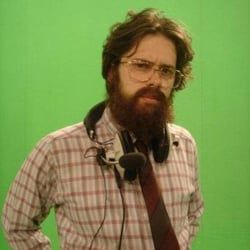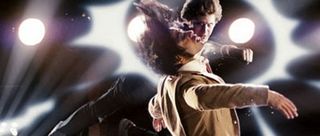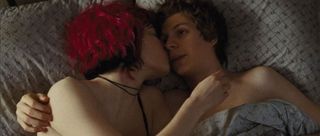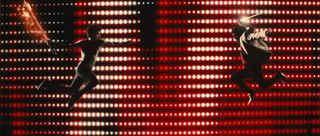Interview: Scott Pilgrim Director Edgar Wright

Despite having only two films, a television series, and a fake trailer under his belt, Edgar Wright has developed a massive fan-base. In reality, however, that’s what happens when your first two movies are Shaun of the Dead and Hot Fuzz. In addition to being the director’s first feature without pals Simon Pegg and Nick Frost, Scott Pilgrim vs. The World is also his first work that comes from non-original material. But that doesn’t mean he hasn’t put his own personal spin on it.
The director recently sat down with journalists, including myself, to answer questions about the film, from the casting of Michael Cera and Mary Elizabeth Winstead to what we might end up seeing on the DVD (such as Wright’s expanding waist-line). Check out the interview below.
It felt that the movie was very clear in its vision and focus. Was this what you wanted on screen?
Thank you. I am very happy with it. It is the result of – I’ve been working on this script, in conjunction with Bryan Lee O’Malley and Michael Bacall for five years, at least. I’ve been working on the film, solidly, for two years. So that’s like two solid years of work up on screen, and like the paint is only just drying. We only finished it like two weeks ago, so when we showed it at Comic-Con on Thursday, it was only the second time that I’d seen it, finished, all the way through. I’m very happy with it and sort of – it was incredibly ambitious, but I’m very pleased with the finished thing. It was great watching it with the cast. Michael Cera had not seen it. He is very superstitious and he refused to watch it until he could watch it with an audience. We had three screenings down in Comic-Con, and pretty much all of the cast went back three nights in a row.
That is also the crowd who should embrace the film and they loved it.
No, it’s great. I think it’s funny, there was one review that sort of accused it like, “Of course Comic-Con would love it! It’s made for them. They are guaranteed to lap it up.” I don’t think that’s necessarily true because if they don’t like something, they will eat you alive. If anything, you’ve got your hardest critics in the room because they know the books inside-out, and obviously we had to take some liberties with the books to make it into one film. If they didn’t like it, we would have also heard that as well. I was personally very pleased that everybody like it so much.
Your shots require certain timing with the actors and might require more takes. What was the attitude from the actors? Did you ever encounter any problems?
CINEMABLEND NEWSLETTER
Your Daily Blend of Entertainment News
I think, and this has been the same since I did Spaced, the TV show like ten years ago, is that I’m very specific in what I want from the actors, but I’m also very clear in what I want from them. So, I’m not asking them to do lots of takes just without ever explaining why. You hear stories of Stanley Kubrick where he would make them do 80 takes, but he would never say what he wanted from them between the two takes, and they would get driven crazy by that. I would hope that I’m very specific in what I’m asking them to do, and also can tell them exactly how the scene is going to play out and what angle is important for which line. I try to edit it in my head, or even with storyboarding – even if I cover it in such a way that’s a bit more intensive than your average comedy, I can be really clear with the actors what I want and what shot is important for what line.
So, I try to hold people’s hand because it’s a balancing act if you are trying to make something visually more interesting, as a comedy, you do have to think about the actors getting tired out, and also the different actors have different work methods. Some people are brilliant on the first take, some people are brilliant on the fourth take, and when you are doing a group scene, you kind of have to figure that out. I mean, at the end of the day in the editing room, you always go for the best performance take no matter what. Even if there’s something like that take was great but the track was a bit bumpy, you figure that shit out because the best performance take is the best performance take and that’s the end of it.

Could you talk about your casting choices? More specifically, Michael Cera and Mary Elizabeth Winstead?
Michael was my first and only choice for the role. I’ve been working on this for, like I said, five years and I remember in 2005 writing the first draft of the script and saying to Michael Bacall – we were watching a lot of “Arrested Development” at the time – “Oh, it’s a shame that George Michael kid isn’t older. He’d be perfect for Scott Pilgrim.” And then cut to 2010 and he’s 22 and the character is 22 and we’re all good. It’s interesting that some people reading the comics see Scott Pilgrim as a blank slate in that they like to imagine themselves as Scott Pilgrim, so it’s interesting that there are two kind of schools of thought about the character. One is like Scott Pilgrim is awesome. The second is Scott Pilgrim believes himself to be awesome. Me and Bryan Lee O’Malley were always in the latter camp, and as such, I think Michael Cera that I can think of who can pull off the charm, the goofiness, the massive insecurities that Scott Pilgrim has in the book and in the film, and also it would be fun to watch him being a badass. And it would be a fun, entertaining, novelty to see somebody who isn’t an action star doing big action scenes. And as a sort of challenge, you know, can we get Michael Cera to a Kill Bill level and stuff? That was it for me. And he was Canadian.
And Mary Elizabeth?
The first time I saw Mary Elizabeth Winstead was in Death Proof, because I was involved with Grindhouse and I did one of the trailers for Grindhouse, and seeing her in Quentin’s film Death Proof – and I think Michael Bacall was there as well – and I said, “Ah, I think Mary Elizabeth Winstead is our Ramona!” It was kind of funny because even though she’s been in things, she hadn’t really played this part and I wanted to find somebody who was a little less known and a bit more mysterious, and maybe occasionally from the studio I’d get some suggestions of going to a more A-list person, but I thought it interesting, just on a dramatic level, to have somebody that not all of the audience would know. She’s just perfect for the role because she embodies that outer and inner-strength. She is kind of playing a broken version of herself. Ramona isn’t quite as strong and confident as she lets on. There is kind of an inner sadness to her. I thought she was just perfect for it. Also! She is from the same area as Ramona, which is spooky and I didn’t know at the time. Ramona, in the books, is from North Carolina and so is Mary Winstead.
What was it about this world and these characters that made you want to do it in the first place? The references to the video games, were those personal? Did you grow up playing video games?
Yeah, I think so. Bryan, I think, is four years younger than me and even though he’s from Canada and I’m from the U.K., this generation grew up on a similar thing and we both had a similar diet of computer games, consoles, films and music, comics, and Saturday morning cartoons, and Japan-amation. I think, really, what sold me about it was I loved the central message for the books. I loved the idea of somebody literally fighting for love. I liked, because I’ve dealt with it before in the TV show “Spaced,” the idea of characters’ lives being governed by the pop culture they consume. I liked the idea of going further with that. Like, in the TV show “Spaced,” there were dream sequences and people wake up, and Scott Pilgrim is like a dream sequence where the character never wakes up. You could even see the film – if you want to put some Inception theory into it, but you could even see Scott Pilgrim as a film where the lead character never wakes up from his daydream. There’s a point where he walks into the bathroom and then walks out into the school corridor and it’s never clear, from that point on, whether we’re in the real world or not anymore. I say not.

How do you balance the craziness with the realness of the relationships between the characters?
Well I think at heart, it’s not as simple as boy meets girl, boy gets girl, it’s really about young love and the ups-and-downs, the immaturity, and insecurities of love at that age. Scott Pilgrim is adolescent and the way that he thinks about a new relationship is it’s the best thing ever and the way that he feel about a break up is it’s the worst thing ever. At that age, you don’t know any better. You don’t have any life experience and you haven’t – Ramona is different because she’s had seven relationships and seven relationships that she probably cares to do things a lot differently. So, you have two characters who meet and they want different things. Scott wants the fairy-tale sort of dream girl and Ramona wants just a nice guy and something kind of casual. He is going out with her, seemingly, just for self-esteem – as an ego boost – and when Ramona is dating him as a quiet break to be with a nice guy after seven douches, and he doesn’t know how he feels about that. I like that idea that within the film there are kind of grey areas.
It wasn’t completely a fairy-tale thing. Even the quest that is set up – can you defeat these seven exes for the fair hand of this princess? At a point in the film, Scott Pilgrim isn’t even sure if he wants to fight anymore. Then when he is fighting it, is he fighting it for the wrong reasons? Is it less about the girl and more that he’s jealous of the other guy and wants to defeat Gideon out of pure jealousy? There is a scene in the film where he literally like a green-eyed monster to defeat the next exes. He is sort of powered by the dark side. The idea that if Scott Pilgrim gets dumped, will he become one of the evil exes?
Have you started writing the script to complete the trilogy with Nick Frost and Simon Pegg?
No [laughs]. I always feel bad when people ask me questions about projects because I started making this full-time in July 2008, and I literally finished the film two weeks ago. All of the projects that I had from back then, I have no new news other than I’m going to return to writing varied things once this is done. I’m going to take a little break and then get back to writing.
Do you know what will be next?
I don’t know. You know, I don’t make those decisions [laughs].
The ending originally had involved Knives, was that ever recorded?
I don’t want to talk about the ending because then it gives away the ending of this film.
So I can’t ask you about book six?
It’s not really fair for people who haven’t seen the film or read the book six to talk about the ending. That talk can wait until the DVD comes out.
What are some of the plans for DVD release?
Oh my god! These days, you have to finish the extras by the time the film comes out, which is – on one hand it’s crazy. On the other hand, it’s kinda nice because when the film is out, it’s finished. God, there’s so much stuff. I just watched the making of the other day, which is like an hour long, and it’s amazing. Although, the worst thing of the making of is that I did the fight training with them at the start, so at the start of the making of, I’m in such good shape! Then during the making of, I put 30 pounds on on camera! I was watching this making of going, “Oh my God! This is like watching fucking Raging Bull! It’s so fucking depressing watching this making of!” At the start of it I’m in fighting shape – I worked out with them for 8 weeks every day, and then as soon as we started filming, no gym for five months.
It is like Peter Jackson backwards.
Yeah. Although, he did get bigger during Lord of the Rings.

One of the actors mentioned that you never sat down for more than two seconds during filming.
Yeah, I don’t like sitting. I have a director’s chair on this one, but I don’t like sitting on it. I feel like if I sit down, I’ll just switch off. You get some directors, and I can never understand it – there’s a thing they call the “video village” where all the monitors are and you’ve probably seen it on set visits – I hate that! I never ever like sitting in video village. I get either my own monitor or a hand held monitor and I stand right by the camera. I’m always up with the camera and the actors. I hate being removed from the epicenter of things. You know, the camera crew has to stand up all day. The actors have to stand up all day. I was thinking I’d rather be in the thick of it. So, I try to keep on my toes, literally.
For the DVD, have you recorded the director’s commentary?
I’ve done one. I’m doing two. I did one with Bill Pope already – the DP – which was really fun. I’m going to do one with Bryan Lee O’Malley and Michael Bacall, and then the cast are doing the two cast commentaries tomorrow. So, there will be loads of stuff. There’s so much making of stuff because there were so many videos that me made of stunt rehearsals and fight rehearsals and all sorts of things. It’s crazy. There’s even what we did to get the greenlight for the film, because we had the script, the books, and even some of the casting in place, but I was constantly being asked the questions, “So what’s it going to look like?” We asked Universal to give us a small amount of money for a test and we shot a test in July 2008, where we shot part of the Matthew Patal/Scott Pilgrim fight with two stunt men. Now what’s funny about that is, the guy thinks Scott Pilgrim is super ripped. We had two stunt people playing Scott Pilgrim and Matthew Patal.
That’s on the DVD?
Yeah, yeah. It’s fun to watch because it is sort of – you can see the start of the style.
Will there be bloopers or outtakes?
There are some bloopers, but everybody was very professional on this. There are normally people who crack up – Jason Schwartzman doesn’t crack up a lot, but he does goof around in between takes. He came right at the end of the schedule when everybody was exhausted. When we shot the last fight scene on the pyramid was nearly the death of all of us because it was incredibly – not only is it a complicated scene, but I work really fast and yet that pyramid scene kind of defeated me because every time you had to do a new shot, you had to move these massive platforms, for safety, because we were over 100 feet in the air. Rather than have all the cast on wires, we would have these big platforms go around. Sometimes I shoot over 40 set ups a day, then when we got to the pyramid fight, it was less than 10 set ups a day. It was really difficult. Thank God Schwartzman was in that scene, and it was his first scene, basically he was a warm-up MC. He kind of refused to let anybody – to let the party stop. He kept everybody entertained because he could see everybody was really tired. It was a godsend having him around.
This project seems very unique. If you see other people trying to do films like this, would you be upset? Happy? Flattered?
I mean, I’d be flattered. There’re plenty of filmmakers that I’ve paid homage to. You know, when we showed Shaun of the Dead to George Romero, he was absolutely thrilled. He couldn’t be nicer about it. He’s mentioned it in every interview whenever people say, “What’s your favorite zombie film?” He says, “Shaun of the Dead.” I couldn’t ask for a better review. I could retire just on that – he said that. Yeah, you know it’s flattering if people that you’ve inspired – in the U.K., there has been a wave of Shaun of the Dead inspired films. People don’t always necessarily admit to it, but it’s flattering if you have an impact that somebody would want to do the same thing.

What was it like working with such a large, ensemble cast?
It was great! I mean, Hot Fuzz had a large, ensemble cast. There’s a scene in Hot Fuzz with fifteen actors, all with speaking parts, which is probably the most difficult scene I’ve ever had to shoot; much more difficult than an action scene because you have to do coverage – if you’ve got great actors for every single role, you have to do coverage. What was funny is in Hot Fuzz, I had actors in their 60’s and 70’s, and here the oldest actor was 29. But it was great! I know this is a cliché, but the cast – for something like this, which we shot for over five months, and at times is incredibly meticulous during the fight scenes, it helped that everybody really got on and that they were a big family.
So, it was great. It’s interesting, I think with an ensemble – hopefully people watch the film more than once – you can actually start to watch the bit players like Kieran Culkin said a funny thing. He said, “You can watch a completely different film if you just watch Johnny Simmons in every single shot.” Which is absolutely true! If you look at Johnny Simmons in the last shot in the film, which most people don’t spot straight away, he does something so stupid in its final shot, and it makes me laugh every time. That’s very true to the books. In the books, there’s this kind of peanut gallery feel where there’s things going on and nothing going on in the background, and the ensemble is always doing something in the books. I tried to pull that off in the film as well.
This movie has a gamer sensibility to it, but your films are grounded with a relatable story. Is that something you are drawn to in general?
I think it’s really important and I think it’s kind of something you have to ground – especially in this film, and in Shaun of the Dead and Hot Fuzz – you kind of have to ground the craziness in something realistic, and usually that comes from the characters. In this, Michael Cera, to me, is the perfect actor for it because he consistently undercuts the insanity that’s going on. It’s almost like his laid-back, Canadian sensibility is perfect for it. I would kind of get that from Bryan Lee O’Malley – talking to him – I would start to read the books in his voice. He would have a particular, mellow tone. And also with this, I think sometimes when people maybe saw the first trailers, I think people assumed it was going to be a total green screen fest. I think that is something – even though the visuals get particularly stylized in places – it was really important to have real locations, real sets, things that people can touch and put their feet on. You’re in real environments.
You know Speed Racer, or even some of the green screen films like the Star Wars prequels – if I had a complaint against the Star Wars prequels compared to the original ones is that there’s nothing! There’s no hardware! You know, there’s nothing to touch anymore! You can tell in the Star Wars prequels, and this is no controversy because Ewan McGregor certainly said out loud that it was kind of boring not having any sets. If you were there in the 1970’s ones, the Millennium Falcon is something that’s there and you can touch it. It adds so much to the performances. So I think with this, even though there are crazy fight scenes and fantastical things happening, we had real sets and people were in locations and could literally have their feet on the ground. But I think it’s hopefully clear that there is an emotional throughline to the film. It’s always about the love story, even the kind of wildest fight scenes are all big, fantastical outpourings of how Scott Pilgrim is feeling at that time. Essentially what you’re watching is an exaggerated version of events. The whole thing is a metaphor for fighting for love and the different fights are a crazy interpretation of his own emotions. So, we always try to kind of keep it like a foot on planet Earth. As much as it goes completely bananas.

Eric Eisenberg is the Assistant Managing Editor at CinemaBlend. After graduating Boston University and earning a bachelor’s degree in journalism, he took a part-time job as a staff writer for CinemaBlend, and after six months was offered the opportunity to move to Los Angeles and take on a newly created West Coast Editor position. Over a decade later, he's continuing to advance his interests and expertise. In addition to conducting filmmaker interviews and contributing to the news and feature content of the site, Eric also oversees the Movie Reviews section, writes the the weekend box office report (published Sundays), and is the site's resident Stephen King expert. He has two King-related columns.
Most Popular



